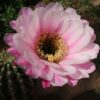
Trichocereus glaucus, also known as Echinopsis glauca, is a Peruvian Trichocereus species described by Friedrich Ritter. It might be synonymous with Trichocereus chalaensis, or at least related to it in some form. There are also Peruvianoids that are sold under this name and I occasionally encountered Trichocereus fulvilanus being sold under this name as well. The whole complex is chaotic and it´s hard to verify which plant Ritter´s description was covering.

Trichocereus glaucus – Foto: Friedrich Ritter
Origin of Trichocereus glaucus:
Peru ( South Peru ), Arequipa (Rio Tambo), Chile. In Chile, this plant is closely related to Trichocereus fulvilanus and Trichocereus deserticolus.
Description of Trichocereus glaucus / Echinopsis glauca:
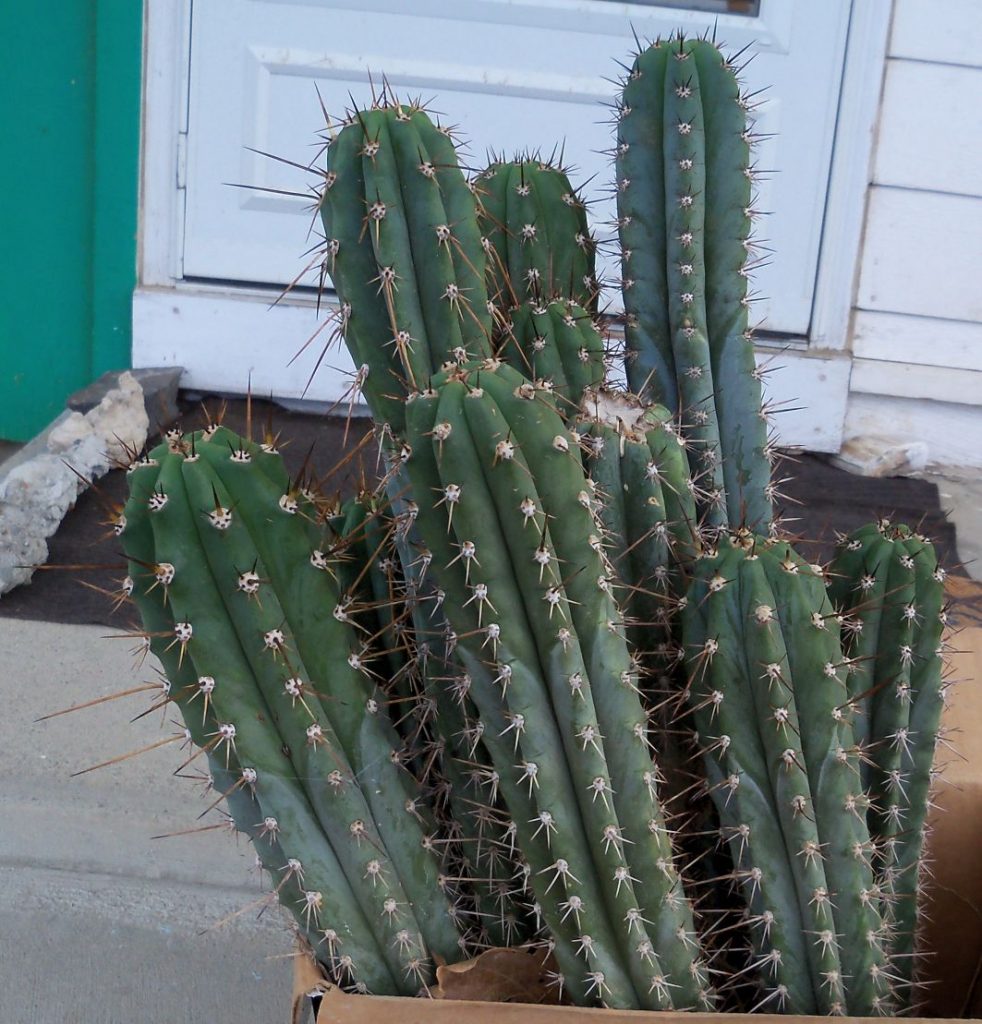
Trichocereus glaucus can get between 1,5-2 meters tall and is a prostrate/creeping species that you often find hanging down slopes and cliffs. This trait is very distinct in the variety Trichocereus glaucus var. pendens. The color of the skin is very glaucous and small specimens look absolutely like the type of plants that are labeled Trichocereus macrogonus / Echinopsis macrogona today. Spiny, dark blue versions from the complex around T. peruvianus. However, macrogonus grows columnar while this species tends to bend over with age. New growth is very glaucous.
Areoles of Echinopsis glauca:
The areoles are dark brown to gray in color and approximately 2,5 centimeters apart of each other. Similar to other plants related to Trichocereus peruvianus, the plant has a diameter of up to 10 centimeters and the areoles are gray felted. The spines look a bit like the ones on Trichocereus cuzcoensis and old growth has a typical satin white glow that is common on this species. Trichocereus glaucus has 6-9 ribs, 3-6 middle spines and 8-11 radial spines. The middle spines are 5-10 centimeters and the radial spines 1-2 centimeters long. New spine growth is black to brown and turns gray with age.
Flowers of T. glaucus:
White, just like almost every other Trichocereus from this complex. The diameter is very variable and usually is between 15-22 centimeters. Trichocereus glaucus is a night-flowering species with green, round fruits. However, the hairy flowers usually stay open until the next morning.
Fruit of E. glauca:
Round, green, and 3 centimeters thick.
Type locality: Lower part of the Rio Tambo in the department Arequipa.
Trichocereus glaucus is very similar to Trichocereus chalaensis and grows in a similar way. We think that Trichocereus chalaensis might be synonymous with Ritter´s Trichocereus glaucus. Ritter´s field number of Trichocereus glaucus was FR270. We distributed seeds of Trichocereus glaucus various times in the past and all ended up amazingly beautiful. It´s a very nice species.
Buy Trichocereus glaucus seeds:
Trichocereus glaucus aka Echinopsis glauca is extremely rare and most plants on the market will probably come labeled as “Trichocereus peruvianus” or “Trichocereus macrogonus”. It is common occurence for some Peruvian cactus collectors to label all glaucous Trichocereus species with this name. This is obviously wrong and causes chaos. We sometimes have plants of this species in our Trichocereus Facebook group, which can be found here: https://facebook.com/groups/trichocereus
Cultivation of Echinopsis glauca:
Trichocereus glaucus is a very resilient grower and likes to be watered well in summer. In winter, they should be kept as dry as possible at around 10° Celsius. Seed germinates very well and the plant is usually very tough. That´s also caused by its drought tolerance, which is very typical for these kinds of plants. The species will probably tolerate temperatures between -5° to -7° Celsius over very short time, but I would not stress it and this also depends on many other factors, like general health and dryness. I would recommend keeping at no lower than 10° Celsius in winter.
Varieties of E. glauca: Trichocereus glaucus var. pendens. This variety does only grow hanging down cliffs and small hills. This variety only grows at one location in Chile and is extremely rare. This local population is in the south of Arica, Camarca in Chile. Backeberg suggested that this would be his Trichocereus uyumpaensis, but Friedrich Ritter vehemently disagreed with that. More information is necessary about this topic.
Below: Trichocereus Glaucus – Fotos: Auxin




Translation of Ritter´s description (loosely)
This species forms shrubs the size of 1 – 2 meters and often several meters in diameter, sprouting mainly from shoots that lay sideways on the ground. This plant rarely pups from the top or upper parts. The shoots are 5 – 8 inches thick, erect, later lying in the lower parts, the new shoot blue-green, later gray-green.
Ribs: 7-9, very broad, obtuse, 7.5 to 13 mm high, 15-25 mm wide, notched, with transverse furrows that do not reach down to the separating grooves of the ribs,
areoles: grey felted, 1/2-3/4 inches in diameter, 1 to 2 inches free removal, let down by the humps in the notches
Spines: In the new shoot black to brown, becoming gray, straight, rigid
Marginal spines: 7-10, directed laterally, the lower and lateral 8 to 15 mm long, coarse needle-shaped, somewhat flattened, the upper the upper stronger and not sharply separated from the Central spines.
Central spines: 3-6, very spread apart, subulate in the middle, but usually closer to the top edge and almost in the position of an edge of spine, below 1.5 mm thick
Flower: Not far from the apex, 13 to 19 centimeters long, fragrant, opening in the evening, the morning still open,
Ovary: Green with fleshy green, narrowly triangular, 2-5 mm long, pointed scales and large scales raised bases. The flowers are covered with brown/black hairs.
Partition against the nectar chamber 3-4 mm thick, tube-shaped, 13 to 23 mm long, to the stylus 1to 2 mm wide, brownish, almost openly, with nectar
Tubes:
In addition funnel shaped, 40-65 mm long, the top 2 to 3 cm wide, pale green interior, exterior gray-green, with triangular points, 7.5 to 10 mm long, dark green scales and tufts of hair as on the ovary.
Stamens: white, greenish below, insertions missing on the top 2 to 3 centimeters of the tube to a ring on the hem, pouch pale brown, approximately at half height petals standing
Stylus: pale green, white or pale brownish above, 10 to 11 cm in length, with 14 to 18 mm fall on the 13-16 spread pale yellow stigma lobes, between the pouches or outstanding.
German original description / Deutsche Original Beschreibung:
Büsche von 1 meter bis 2 meter höhe und oft mehreren Metern Durchmesser, sprossend hauptsächlich unten von liegenden Trieben, weniger oben sprossend. Triebe 5 bis 8 Zentimeter dick, aufrecht, später in den unteren Teilen liegend, im Neutrieb blaugrün, später mehr graugrün.
Rippen: 7-9, sehr breit, stumpf, 7,5 bis 13 mm hoch, 15 bis 25 mm breit, gekerbt, mit Querfurchen, die nicht bis zu den Trennfurchen der Rippen hinabreichen,
Areolen: Graufilzig, 1/2-3/4 Zentimeter Durchmesser, 1bis 2 Zentimeter freie Entfernung, , von den Höckern in die Kerben hinabreichend
Stacheln: Im Neutrieb schwarz bis braun, , vergrauend, gerade, starr
Randstacheln: 7 bis 10, seitlich gerichtet, die unteren und seitlichen 8 bis 15 mm lang, derb nadelförmig, etwas abgeflacht, die oberen die Oberen stärker und nicht scharf von den Mittelstacheln gesondert.
Mittelstacheln: 3 bis 6, sehr gespreizt, pfriemlich in der Mitte, aber meist näher dem oberen Rand und fast in der Stellung eines Randstachels, unten 1,5 mm dick
Blüte: Nicht weit weg vom Scheitel, 13 bis 19 zentimeter lang, duftend, abends öffnend, morgens noch offen,
Fruchtknoten: Grün mit fleischigen grünen, schmal dreieckigen, 2-5 mm langen spitzen Schuppen und großen erhabenen Schuppenbasen. Mit starken schwarzen oder braunschwarzen Wollhaaren.
Trennwand gegen die Nektarkammer 3-4 mm dick, diese tubisch, 13 bis 23 mm lang,um den Griffel 1bis 2 mm weit, bräunlich, fast offen, mit Nektar
Röhren: Darüber trichterig, 40 bis 65 mm lang, oben 2 bis 3 cm weit, innen blaß grünlich , außen graugrün, mit dreieckigen Spitzen, 7,5 bis 10 mm langen dunkelgrünen Schuppen und Haarbüscheln wie auf dem Fruchtknoten.
Staubfäden: weiß, unten grünlich, Insertionen fehlen auf den obersten 2 bis 3 Zentimetern der Röhre, bis auf einen Ring auf dem Saum, Beutel blassbraun, etwa bei halber Petalen Höhe stehend
Griffel: blassgrün, oben weiß oder blass bräunlich, 10 bis 11 cm lang, wovon 14 bis 18 mm auf die 13-16 gespreizten blaßgelben Narbenäste fallen, zwischen den Beuteln oder sie überragend.
Photos of Trichocereus glaucus / Echinopsis glauca

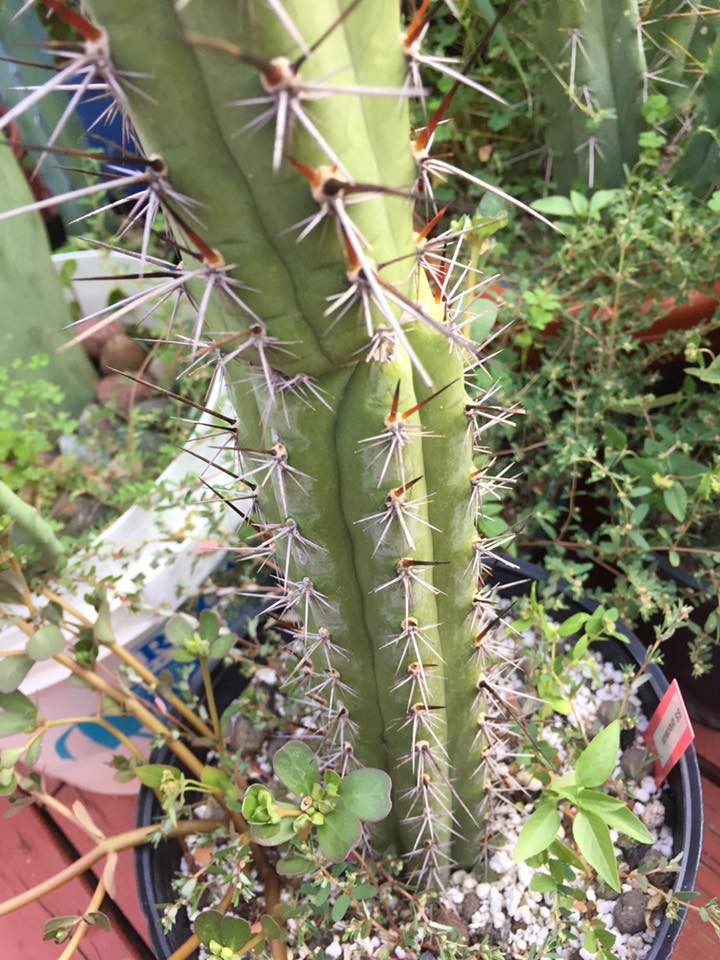




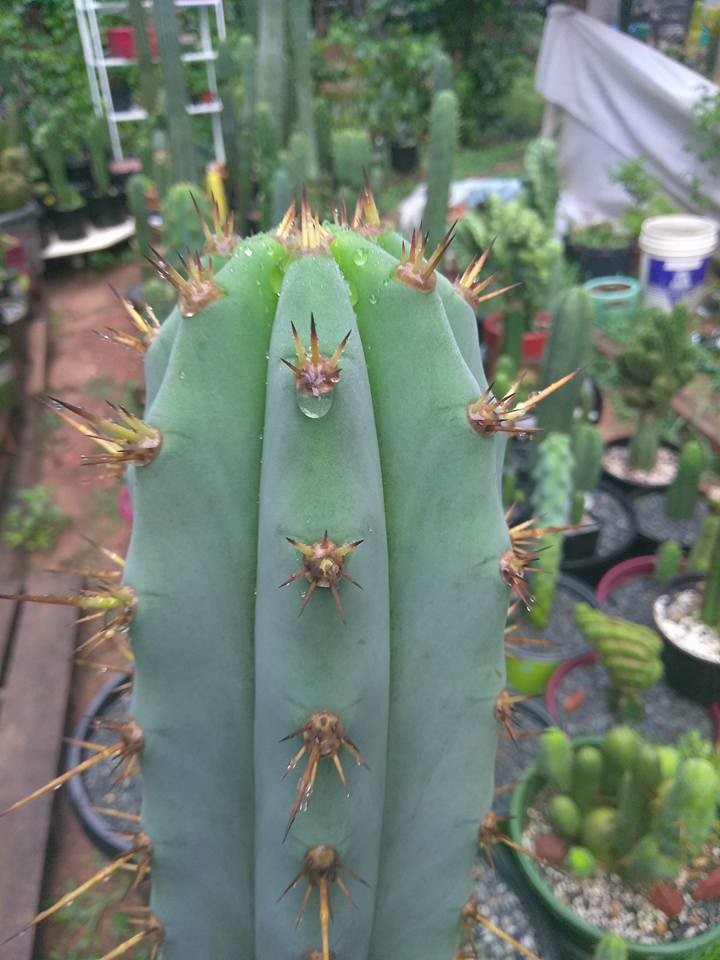






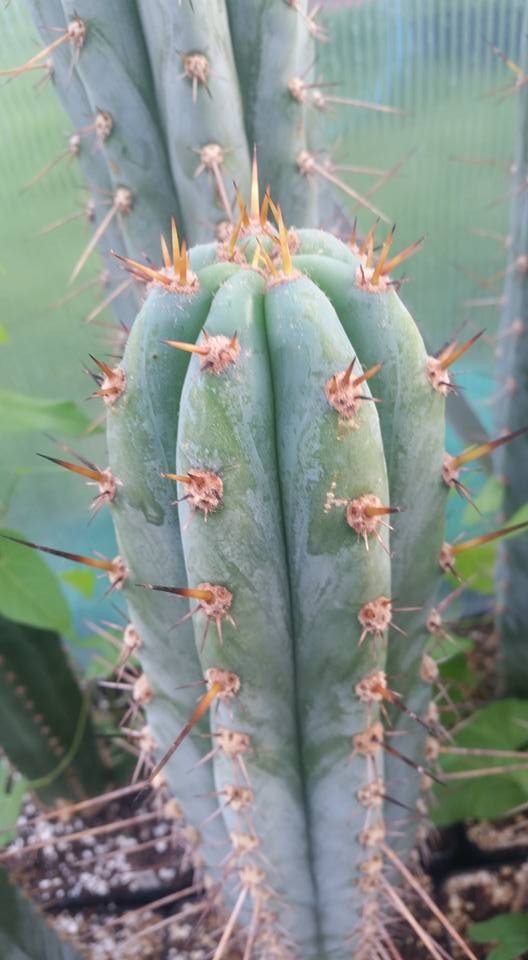
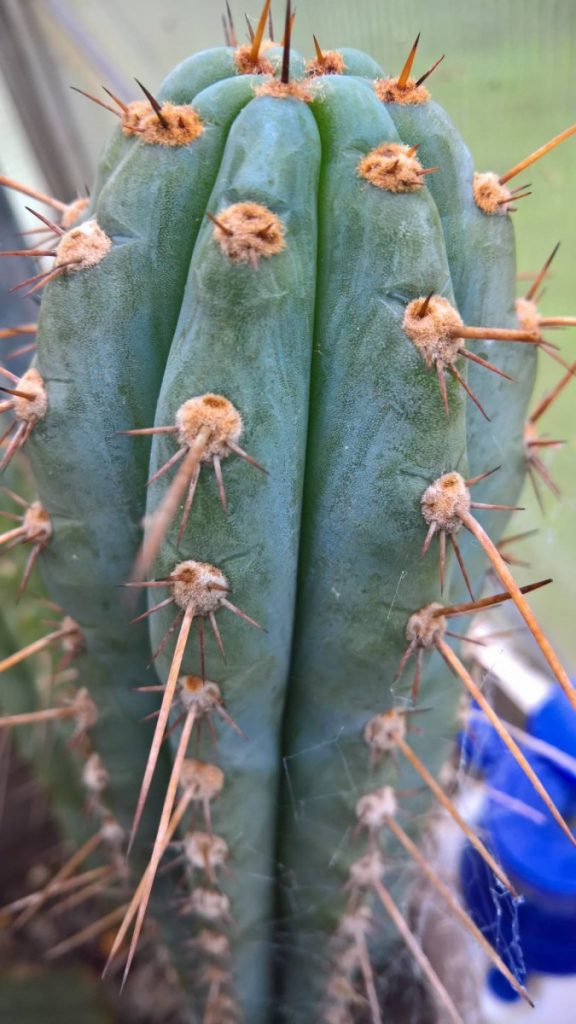

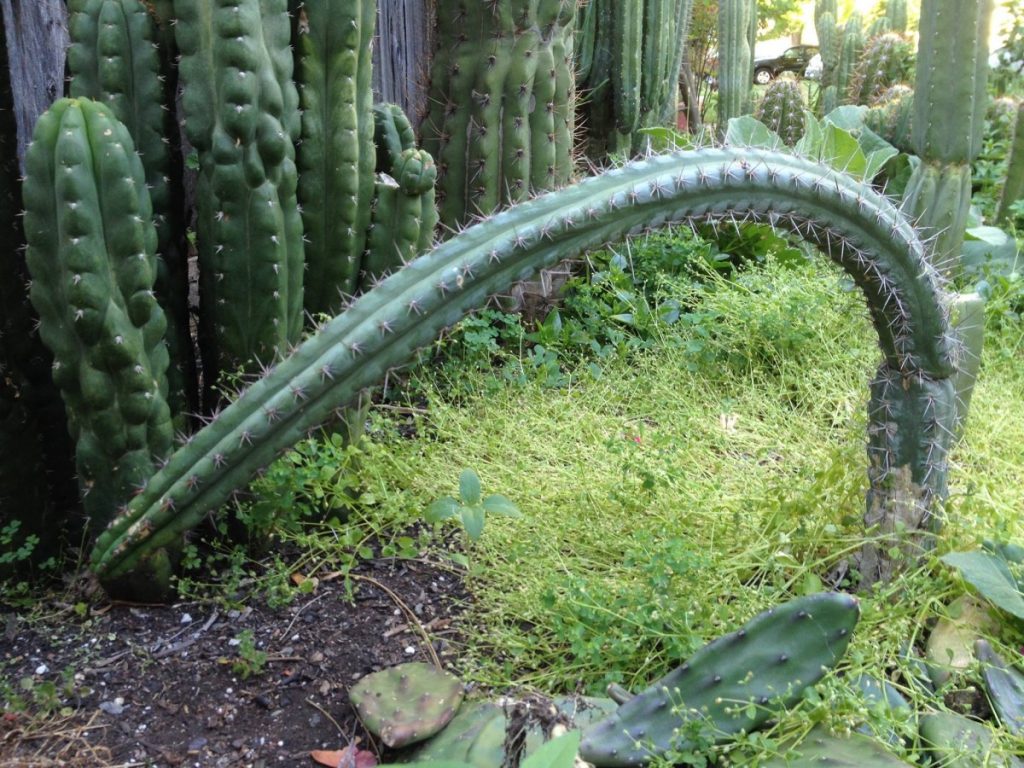

In comparison to this species, check out closely related species:




